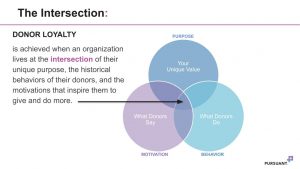Finding Your Intersection (Developing Leadership, Part 2)
In Part 1 of this series on leadership, I shared some ideas around Group Thinking. I offered three specific concepts to integrate into your efforts:
- Creating a binary measurement to define success more objectively.
- Assigning a designated ‘challenger’ to pose questions and break up group thinking.
- Using blended benchmarks to be sure you are not just exceeding the benchmark, but truly meeting your potential.
Today, in Part 2, I’m offering a next step to layer in with these concepts – a next step that helps you find Your Intersection to envision yourself as the leader you want to be.
If you’ve ever attended a Pursuant webinar, requested an overview of our services, or been a client, then you’re likely familiar with the visual below. These three concentric circles are our rallying cry, and their point of intersection is our nirvana.

If it’s new to you, let me break it down quickly. Working clockwise…
- PURPOSE: your organization’s mission. This is the unique value your organization, and only your organization, can bring to the world. It’s the basis of your connection with supporters and what drives them to get, and stay, involved with you.
- BEHAVIOR: what supporters do. This is the recency of their last gift, frequency of their giving, and the monetary value of their contributions. It’s whether they attended your event, opened your digital newsletter, or liked your post on Facebook. It’s how they are involved with you.
- MOTIVATION: what supporters say. This is what people intend, believe, or aspire to make happen. It’s people imagining themselves at their best. It’s why they are involved with you.
I love this visual for a lot of reasons – it highlights that people are more than just one thing (even though they are also more than three), it highlights that people’s choices are not binary and that they can be influenced by multiple factors, and it highlights that what people say and what they do are not necessarily the same thing. This simple graphic is a powerful tool in driving donor loyalty and subsequently, driving revenue that is repeatable and sustainable. But its value does not stop there.
Imagine if we applied this same visual (and its concepts) to our organizations, our leaders, our staff, and ourselves.
It’s easy to identify the things that others can, and should, do better. As humans, we are quick to turn away from the mirror and focus on the window. We can see clearly the behaviors in our spouses, kids, friends, and colleagues that make them extraordinary. And we can see with equal clarity the behaviors that may be holding them back. Unfortunately, when we try to look in the mirror to see those same behaviors in ourselves, it’s as if the mirror is fogged up. The clarity seems to have faded, if not disappeared altogether, and we are left understanding why they call them blind spots. But this simple visual we use to drive donor loyalty can help. Let me show you what I mean.
- PURPOSE: you are a leader in your organization for a reason. You were a candidate – likely one of many – and they chose you. Similarly, you chose them. You feel a connection to the organization’s mission – to its purpose. Before you do anything else, stop, and examine your own connection to the organization. Be curious about what it is, what it was, if it’s changed, and why. Don’t be afraid of or try to distort the reality of your current connection, just be curious and seek to understand it.
- BEHAVIOR: make a list of the behaviors you exhibit, that you are aware of. Then, select family, friends, or colleagues who you can trust to be honest, and invite them to add to your list. Try to observe these descriptions without judgement. Try to be curious about them – how do they help you and how might they hold you back? Spoiler alert: each of them will offer a little of both.
- MOTIVATION: who do you want to be – as a leader? Who do you admire, read, follow and work to emulate? Why? Take the amazing clarity that comes from looking at others and try to define the attributes about them that draw you to them. Then, again, bring curiosity and consider why you find that attribute so compelling. Can you define the way you think things would be if you exemplified these attributes?
Now, let’s revisit why I love this visual, but this time through the lens of your leadership. It highlights that you are more than just one thing (even though you are also more than three), it highlights that your choices are not binary and that they can be influenced by multiple factors, and it highlights that the leader you want to be and the leader you are, are not always the same thing. This simple graphic helps you find your intersection and offers a powerful tool to help you evolve as a leader.
As President Obama said in 2008, “Change will not come if we wait for some other person or some other time. We are the ones we’ve been waiting for. We are the change that we seek.” So, let’s consider today Step Two in a series to impact real and enduring change for our organizations.


